Blog
01/31/2022 Yellowstone National Park Trips--Utah Stops on the Way
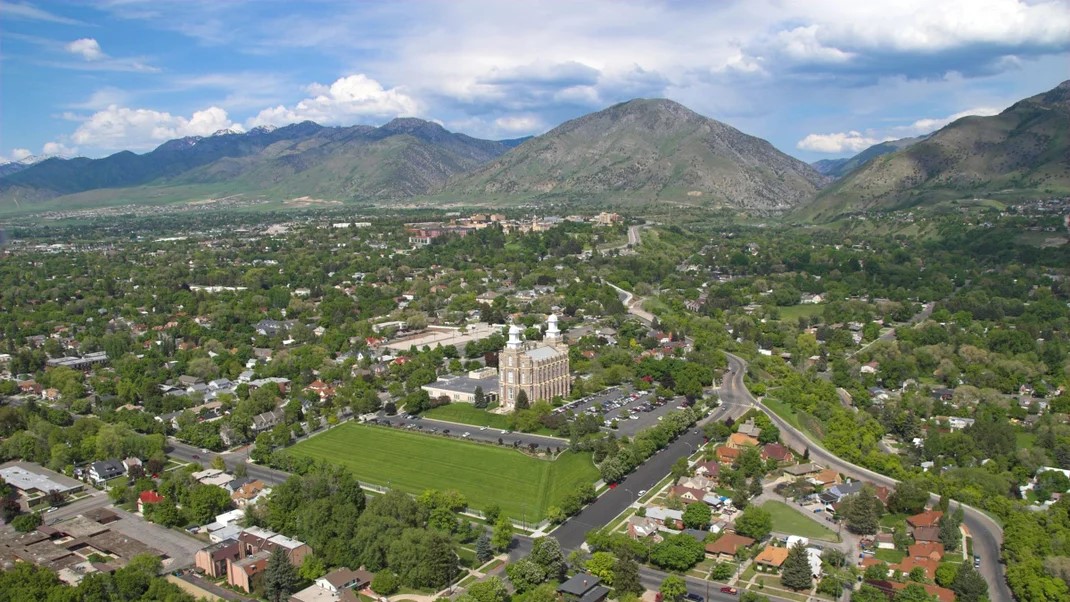
A Local Slice of Western Life in Logan and Cache Valley
Stop in this valley's small, storybook town on the way to Yellowstone.
APRIL 20, 2021 by MIKAELA RULAND
Catch a glimpse into pioneer living and enjoy live theater on the way to Yellowstone with a stop in Logan, Utah and the Cache Valley. Here are our favorite places to get comfort food, go on a hike and see history up close.
Go back in time at the 160-acre American West Heritage Center in Wellsville, Utah. You’ll find interpreters in period clothing to help you learn about pioneer life in the Mountain Man Camp, mock-pioneer settlements and a working farm straight from 1917.

Re-enacting Pioneer Life at the American West Heritage Center Photo: Flickr/Marsha Maxwell
Throw tomahawks or learn to set traps and identify furs with volunteers dressed as mountain men; make rag dolls or compete in a two-man log-sawing contest; learn to spin wool, weave rugs, milk a cow or just enjoy a wagon ride. The Welcome Center features a number of exhibits on local history, plus staff can take visitors out to the center’s bison enclosure for an up-close look at the animals.
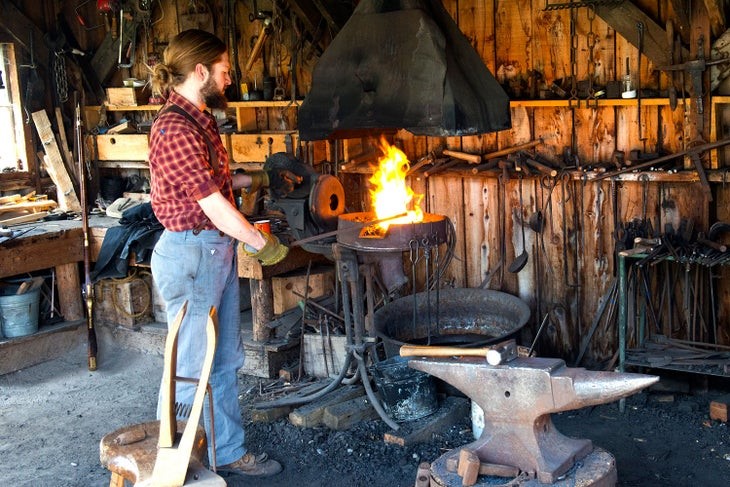
Blacksmith at the American West Heritage Center Photo: by Mike Bullock courtesy of Cache Valley Visitors Bureau
Then, stroll the newly renovated center of downtown Logan, Utah, at Main and Center streets.
“It looks like something out of a Hallmark movie,” says Cache Valley Visitors Bureau director Julie Hollist of the quaint street dotted with colorful hanging baskets and outdoor dining.
The Bluebird Restaurant has been a Logan staple since 1914, making it the longest running restaurant in the state of Utah. You’ll still find dishes on the menu from 1914 like the Teddy Bear Sundae, along with more modern options. The original marble soda fountain still serves up homemade treats. Around the corner at The Factory, you’ll find the Bluebird’s handmade candy being created. Stop in for some chocolate.
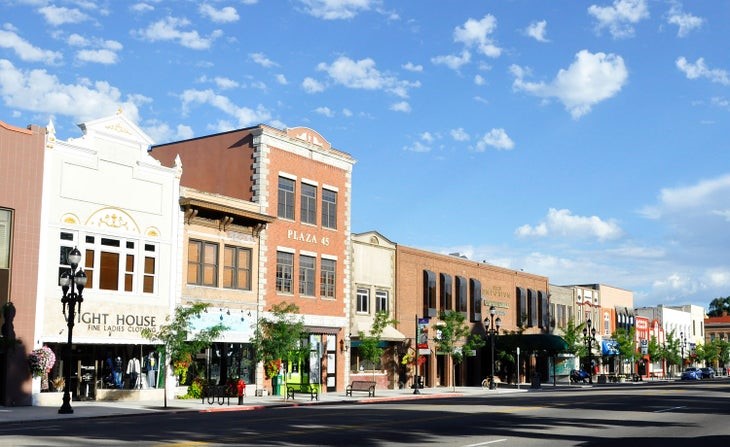
Downtown Logan, Utah Photo: Paul Hermans via Wikimedia Commons
Cache Valley is well known for its locally made products. All of Pepperidge Farm’s iconic Goldfish crackers are made here as well as the swiss cheese that adorns Wendy’s and Arby’s sandwiches nationwide from Gossner Foods. Go on the self-guided Foodie Trek and Signature Products Tour to sample all of the region’s favorite products. The guide can be found at www.explorelogan.com.
If you’re still looking for a taste of Cache Valley head to where the locals hang out, Angie’s, a diner on Main Street, serves up all-day breakfast and renowned pies and cheesecakes. What locals really crave though, are the scones.
“In this part of the country we don’t think of a scone as that crumbly English pastry,” Hollist says. “Order the scone at Angie’s and you’ll get a delicious fry bread. It’s a regional specialty.”
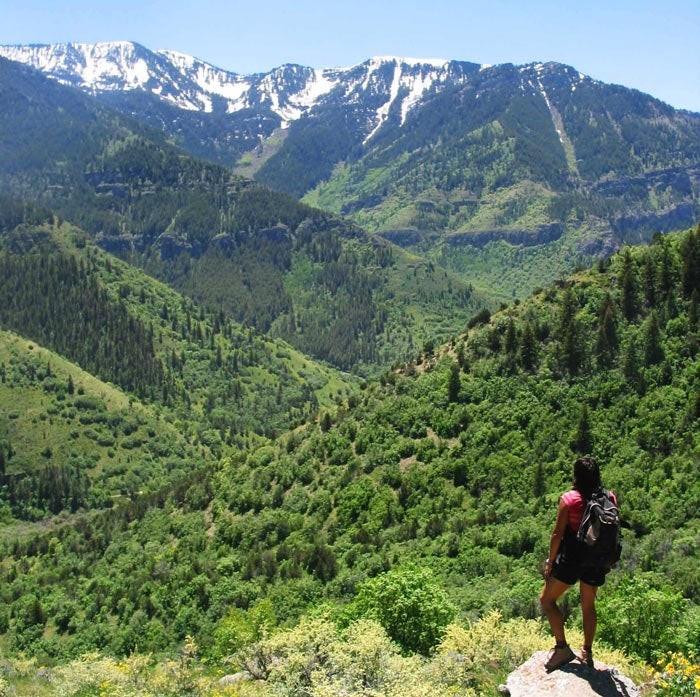
Hiking on the Wind Cave Trail near Logan Photo: by Monique Beeley courtesy of Cache Valley Visitors Bureau
Five minutes from downtown, you’ll find yourself deep in a national forest. Head up Logan Canyon for a breathtaking scenic drive, ending 43 miles later at picturesque Bear Lake. Stop along the way at one of the 26 trailheads such as Wind Cave, which will bring you on a steep-but-worthy 4-mile, round-trip journey to an interesting cavern with views across the canyon to the China Wall, a limestone cliff.
Or, stop at Beaver Creek Lodge to go on a guided horseback ride through the beautiful landscape. In the winter, Beaver Creek Lodge rents snowmobiles, or you can ski across the street at Beaver Mountain, the oldest continuously-owned family ski resort in the US.
To top it off, every summer, Cache Valley becomes Utah’s “Heart of the Arts,” featuring three live-performance theaters with live-in opera and musical theatre stars from across the world coming to Logan to perform with a full orchestra. Visit www.explorelogan.com/calendar.html for the most up-to-date information.
03/11/2019 Logan, Utah: High Art and Hometown Americana
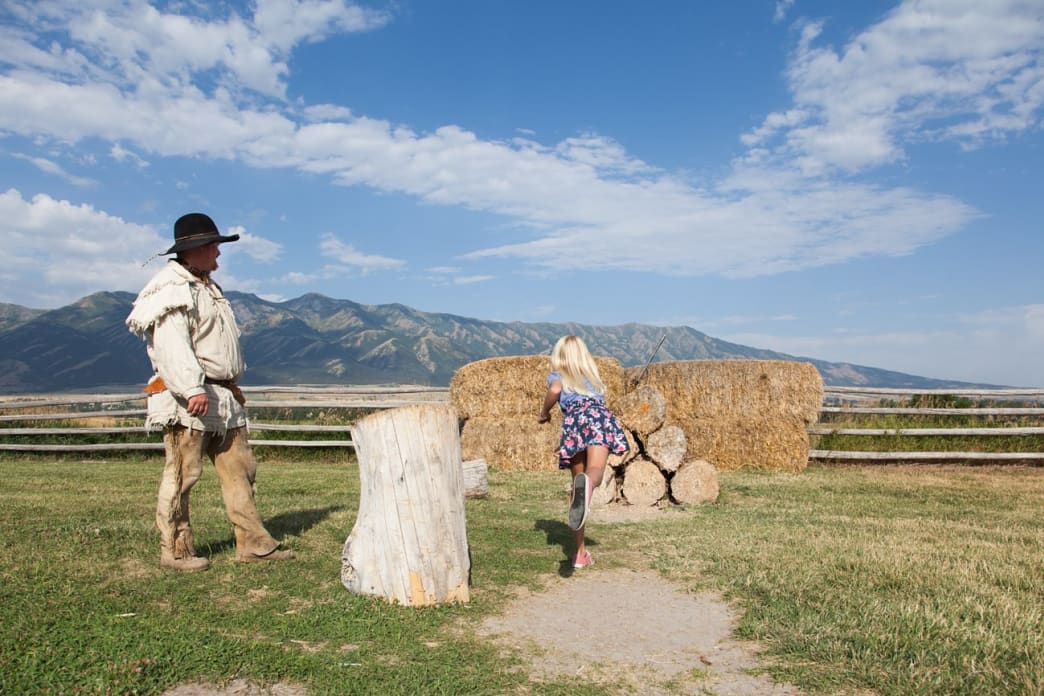
The old west in modern day: American West Heritage Center
A hush fell over the crowd as the chandeliers rose toward the ceiling and a Mighty Wurlitzer Organ emerged upward from the stage in the 350-seat Utah Theatre. Professional theater organist Mike Ohman rose to applause and explained a bit about the silent film we would soon watch: 1923’s “Safety Last” starring Harold Lloyd.
Ohman explained how Lloyd, who did his own stunts, lost parts of his hand in an accident on a previous film set and wore a flesh-colored prosthetic glove to hide it. After his short talk, Ohman sat behind the Wurlitzer and played as he and the organ slowly sank back into the stage as the film started to play. It was an unforgettable entertainment experience for theatergoers.
Theater in Logan, Utah, isn’t just a passing hobby — it’s a way of life for many residents. The quaint, nostalgic town is home to three historic theaters within a single block’s radius.
The 1913 Caine Lyric Theatre ... supposedly has a ghost named Everett. Rumor has it, Everett was an actor slain by a costar for stealing too many laughs on stage.
“This whole block is filled with memories,” says Michael Ballam, founder and general director of the Utah Festival Opera & Musical Theatre.
When he was 19, Ballam left his hometown of Logan to become an opera singer. But twenty-five years ago, he became very ill and doctors told him to prepare for the worst. He returned to Logan and, soon after he arrived, he discovered his cherished Capitol Theatre was going to be demolished.
Ballam worked to save the theater, raising millions of dollars to transform it into the Ellen Eccles Theatre. He also found a surgeon who was able to perform an operation and restore his health. After he recovered, Ballam decided to stay in Logan and delved right into the town’s theater world.
“My life has always been telling stories on stage to music,” Ballam says.
And Logan is the perfect backdrop for storytelling. Surrounded by stunning mountain scenery, Logan’s friendly, small-town, Americana ambiance is evident from a visitor’s first hour in town. The college town — home to Utah State University — is located in the Cache Valley in the north of Utah, which has a strong agricultural and pioneer heritage.
Deeply Rooted Heritage
Evidence of this rich heritage is easy to find. The 160-acre American West Heritage Center just south of town is a living history center showcasing the region’s heritage with costumed mountain men, pioneers, and farmers portraying a bygone era.
The center’s “historic daily adventures” take learning to another level, and include a Native American encampment, mountain man camp, and pioneer settlement where you can explore a dug-out, cabin, and even pull a handcart. Pony rides and train rides are available for little ones, and Friday Tea Time is a fun time for kids to dress up and learn about old fashioned etiquette while trying tea cakes, lemonade, and enjoying parlor games (reservations required). The woodwright shop is a great opportunity to learn about historical woodworking techniques, and the historical farm offers a peek into old-fashioned ways, from cooking to farmwork.
Modern-day farmers can be found at the Cache Valley Gardener’s Market, where shoppers listen to live music and search shop stands brimming with produce, honey products, cheese from nearby dairy farms, eggs, and a number of other locally-produced items. Food trucks, dessert vendors, and a kettle corn stand offer good eats and fill the air with enticing aromas, and friendly artisans sell handmade bracelets, baby blankets, art, photography, ceramics, and even beard oil.
The family-friendly market takes place outside of the Cache County Historic Courthouse, one of the many turn-of-the-century buildings located downtown. A pleasant afternoon activity is strolling around, soaking in the sights and catching an eyeful of stunning Mormon pioneer architecture along with a free noon concert (on summer weekdays) at the Logan Tabernacle.
The Show(s) Must Go On
Just a short walk away, Logan’s three theaters come alive each summer with world-class performances. The Lyric Repertory Company puts on a rotating series of performances in the 1913 Caine Lyric Theatre which supposedly has a ghost named Everett. Rumor has it, Everett was an actor slain by a costar for stealing too many laughs on stage.
During my three days in Logan, I didn’t see any ghosts, but I was fortunate to attend a trio of performances: "You Can’t Take it With You" by the Lyric Repertory Company at the Caine Lyric Theatre and "Show Boat" and "Porgy & Bess" by the Utah Festival Opera at the Ellen Eccles Theatre.
The Ellen Eccles Theatre, opened in 1923 as the Capitol Theatre, was lovingly restored and reopened in 1993 with its new name under Ballam’s leadership. The location seats 1,100 patrons and — a little known fact — offers incredible backstage tours.
Offered first thing in the morning, the tours provide a sneak peak into the world of the theater before it truly comes alive for the day. A dozen or so backstage tour-goers and I sat in the theater’s storied seats, soaking up local history from a very knowledgeable tour guide before venturing backstage where crew members were beginning to prepare for the day’s performances.
We saw the enormous collection of sets backstage, took a peek into empty dressing rooms, and explored the costume room, packed with hundreds of items neatly sorted by show and character. A sewing machine stood at the ready in case of last-minute wardrobe malfunctions. Our tour guide even let us in on a little-known secret: a spray bottle of vodka is often used to “clean” and deodorize costumes between performances.
The highlight of the tour was a trip into the orchestra pit where a full orchestra of 40-60 members, including performers from the Metropolitan Opera as well as Broadway performers, bring the shows to life each day.
Deep, personal connections are evident in the theater community, and many theatergoers have bought tickets to these shows for decades.
Backstage tours aren’t the only way to take a behind-the-scenes peek into the Logan theater scene. Before each Utah Festival Opera show, free “Informances” offer history and background about each show.
I attended an Informance before a matinee of "Porgy & Bess." Though my seat for the show was high in the balcony, the friendly ushers encouraged me and others to move down to the front and get close to the stage for the talk. A tuxedo-clad Ballam shared the story of composer George Gershwin and "Porgy & Bess." It was the last day of the season, and Ballam became emotional as he encouraged everyone to take an opportunity to meet the performers in the lobby after the show. “I’ve come to love each and every one of these people,” he said. “They’ve changed my life for the better.”
These deep, personal connections are evident in the theater community, and many theatergoers have bought tickets to these shows for decades.
“We’re really lucky to live where we live and have the support of the community and guests who come from out of town,” says Richie Call, co-artistic director of the Lyric Repertory Company. “Without them, we don’t think we could do what we love to do.”
Pairs Well With Coffee
In addition to the local theater scene, Logan residents have yet another reason to be grateful for their luck: the local restaurants. The town is packed with unique, local dining options. Angie’s is a classic, small-town diner offering a full menu of homemade food from scratch, including the “Kitchen Sink” challenge where diners see if they can devour an enormous banana split from a sink-like apparatus.
Caffe Ibis is an internationally renowned coffee shop with triple-certified coffee that is organic, fair trade, and songbird-safe — not to mention delicious. The shop is also an art gallery, clad in distinctive works, including images of the cafe’s namesake bird. Housed in a former train station, Cafe Sabor is a Mexican restaurant with a historical flair and top-notch burritos. Crumb Brothers crafts delicious mouth-watering sandwiches on organic artisan breads.
Aggie Ice Cream offers up 30 flavors of tasty delights, and True Blue Cheese crafts Old Aged Juniper Cheddar, Crimson Trail Jalapeno Cheddar, and other wonderful cheeses. The best part? Both dairy shops offer factory tours.
After three days of eating and taking in highly acclaimed performances, it was time to head home. I was also ready to stretch my legs. The Logan Canyon National Scenic byway just outside of town heads east through the photo-worthy hills of the Uinta-Wasatch-Cache National Forest, ending at Bear Lake. Along the way, you’ll find hiking (including routes to several caves), mountain biking, fishing, birdwatching and more. Shady, riverside picnic areas line the road and camping is available.
As Logan fades in the rearview and the canyon entices me further along, I think back to the performances I saw and the people I met in Logan. I thought back to my meeting with Michael Ballam and his overwhelming passion for theater and opera, the wonderful performances I was fortunate enough to enjoy, and, most of all, the overwhelming kindness of every Loganite I encountered during my time in town; there’s a lot to love about this little town.
IF YOU GO
Located just south of scenic Logan Canyon, the town of Logan, Utah, offers a slice of small-town Americana and world-class art and culture, all rolled into one. It’s just an hour and 20 minutes from Salt Lake City International Airport, but a world away from the hustle and bustle of big-city life. Stunning Bear Lake is just 50 minutes to the northeast of Logan and a fantastic family day trip — don’t forget to get a raspberry milkshake.
WHEN TO GO
Summer is the best time to take in the arts and culture of Logan. The Lyric Repertory Theatre’s season is generally June to early August, while the Utah Festival Opera typically runs July into early August.
THINGS TO DO
Utah Festival Opera & Musical Theatre
Operas, musicals, special performances, and concerts fill out a full schedule at the Utah Festival Opera & Musical Theatre.
Tickets $16-79 adults / $8-39 kids 5–18 / $12–59.25 students (2019 prices)
Lyric Repertory Company
Sit in the historic Caine Lyric Theatre and enjoy a full summer schedule of performances.
Tickets $30-35 adults, $21-25 students/children (2019 prices)
Backstage Tours
Delve into the magic, wonder, and history of either the Ellen Eccles Theatre or the Utah Theatre on a backstage tour (offered on select dates).
Tickets $5 (2019 price)
Informances
An hour before each Utah Festival Opera performance, learn about the show with a free 30-minute “informance” where founder and general director Michael Ballam and others share information about the performance, plot, production, and more.
Free
American West Heritage Center
Go back in time to experience the Old West at this family-friendly living history museum. Self-guided tours and seasonal programming available. Prices vary; check AWHC.org for current schedule.
Written by KRISTEN POPE for Utah Office of Tourism.
12/21/2018 Hiking the Jardine Juniper Trail to the Oldest Rocky Mountain Juniper Tree in the World
Trail Guide
Difficulty: Easy
Distance and elevation gain: 11 miles and 2,145 feet
Multi-use: Yes
Dogs: Yes
Fees: None
Seasonality: Year-round
Bathroom: Pit toilets
Where to park: Paid parking lot at the trailhead
Trailhead GPS coordinates: 41.797418, -111.646806
I have always been in awe of ancient trees, so I seek out old-growth forests and long-standing specimens wherever I go. There’s something special about going on a hike and seeing an old tree with its thick, gnarled bark and twisted limbs, suggesting the kind of wisdom that comes only with longevity.
The Jardine Juniper tree of northern Utah’s Logan Canyon is nothing if not long-lived. The tree was once thought to be more than 3,000 years old, but current measurements estimate that it’s probably closer to 1,500 years old — still older than most civilizations that currently exist on our planet. And it’s the oldest Rocky Mountain juniper, as well. It’s a lovely reward after more than five miles of hiking (and ascending some 2,000 feet of elevation gain) along the trail that bears its name.
When the Jardine Juniper tree was just a seedling, Native American tribes roamed all corners of North America, hunting, gathering and thriving off the land. It’s possible that it was alive when great civilizations like the Roman Empire fell. It has lived through the Renaissance, the founding of the United States of America and the Civil War, continuing to deepen its roots, grow new branches and bear cones, all while weathering drought, lightning storms and forest fires.
It’s impossible to look at the Jardine Juniper and not imagine this rich past and the bygone eras it’s lived through. And it’s still alive: Its contorted branches stretch upward and outward, with a small bunch of greenery in its uppermost branches.
Getting Started
The 11-mile round-trip trail, which is an out-and-back until it intersections with the loop section around the tree, is mostly smooth, and its gradual incline lends itself to contemplation. I didn’t feel rushed or out of breath as I hiked — instead, I simply enjoyed the scenery.
The shortest and most traveled way to reach the tree is to begin at the Wood Camp Campground Trailhead, up Logan Canyon Road on U.S. Highway 89.
Logan Canyon cuts through the Bear River Mountains in the Wasatch Range, and the scenic canyon drive winds through thick, dense pine forests to aspens and sparse terrain. Highway 89 has been designated as a scenic byway and I highly recommend driving the whole highway, stopping at different lookouts and hikes along the way.
Park at the pull-out near the campground. The trail begins in a meadow, with open views of the aspens and a few far-off, snowy peaks.
As the path turns to climb up the slopes of Logan Canyon, the trail becomes slightly more strenuous. The climb is well worth the effort, because the higher you go, the better the views of the surrounding hillsides the canyon. You might even be able to see Logan Mountain to the south. It’s beautiful year-round — some people also enjoy snowshoeing the trail — but when I did this hike in the fall, the canyon was lit up in a kaleidoscope of autumn colors.
Wind and climb gradually toward the ridge, taking time to enjoy the aspen forests and open meadows. In the spring, look for wildflowers that blanket the meadows and aspen groves — you’ll find plenty of Indian paintbrush and lupine.
As you approach the ridgeline, be prepared for it to be colder, even in the summer. At mile 3.5, you’ll see a Wilderness sign, and you can continue straight or right on this section.
Seeing the Tree
 There are few living organisms in the world that are this old. Emily Sierra
There are few living organisms in the world that are this old. Emily Sierra
Top out the ridge, and around mile 4.5, you will see two different routes to the tree along this looped section of trail: the “shady” or the “scenic” route. Stay right to enjoy the scenic, high valley views of Logan Canyon, or go left to the shadier walk towards Cottonwood Canyon (this one is slightly quicker).
If you can’t decide, do what I did — take the sunny, scenic route on the way up and the shady route on the way down. If you take the scenic route, you’ll have views of the Bear Range in the Naomi Wilderness. Some of these peaks are over 10,000 feet and retain snow long into the summer.
Finally, at the end of the loop trail, you’ll see a sign that points to the Jardine Juniper tree. Hike downhill to the viewing platform, where you can take your time basking in the glow of Logan Canyon’s longest-standing tree. The Jardine Juniper certainly chose a scenic spot to preside over, with Logan Canyon down below and Cottonwood Canyon to the north.
After enjoying your lunch, head back down the trail the same way you came up.
Trip Planning & Logistics
-
You’ll find pit toilets and picnic tables near the trailhead, but there’s no water here, so be sure to bring plenty of your own.
-
Any time you’re hiking at elevation, take your time and start more slowly than you might be used to.
-
This hike is great for all abilities — just be sure to give yourself 4-6 hours so you have time to rest, especially during warmer months.
-
It can be cold on the ridge, even in the summer, so bring layers and don’t forget sunscreen.
Written by Jacqui Levy for RootsRated Media in partnership with Utah Office of Tourism.
12/21/2018 Two for the Price of One: Exploring the Snowmobile Trails of Northern Utah
Venture off the path and into the epic landscapes of northern Utah, exploring backcountry snowmobile terrain that climbs to 9,000 feet above sea level, winds through forested canyons and opens up into powder-filled meadows that snowmobilers dream about. As you rev your engine and switchback up to epic overlooks of Cache Valley and neighboring mountains, you’ll almost forget that these remote landscapes are just 10 minutes to an hour from bustling Logan, Utah.
Experiences like this are surprisingly easy to find in northern Utah, where snowmobiling reigns supreme in the winter sports world thanks to ample snowfall, abundant trails and easy access. When venturing into the Beehive State’s northern wilds for your own winter adventure, look no further than the following three trail networks for an epic snowmobiling day. Need a sled, gear or a guide? We’ve got you covered with details on local pros who can help.
The Trails
 Guided tours make snowmobiling in easy for visitors to northern Utah. Jay Dash Photography
Guided tours make snowmobiling in easy for visitors to northern Utah. Jay Dash Photography
Hardware Ranch Snowmobile Complex
See wintering elk herds (at a safe distance) while snowmobiling at this winter wonderland near Logan. At Hardware Ranch you’ll ride groomed trails through the Wasatch-Cache National Forest like the beginner-friendly Amazon Trail or the tough, twisty-turning Garden City Trail. Take a warm-up break at the visitor center to learn about the elk and use heated restrooms.
Going north from the Hardware Ranch, find one of the complex’s best uncrowded rides on the Peter Sinks Trail. It’s a local favorite and features playful riding with wide-open fields, rolling hills and plenty of climbing through the forest. However, some of the coldest temperatures in the nation have been recorded in the sinkholes in the area — so dress appropriately. Thankfully, a warming hut is available at the Elk Valley Guard Station.
Logan Canyon Snowmobile Complex
Find 180 miles of well-groomed snowmobile trails in this top-rated riding area in the Wasatch-Cache National Forest. Climb up a winding canyon to an alpine lake on the Tony Grove Trail, or venture up the Beaver Creek Trail for instant access to dozens of trails. If you rent snowmobiles at Beaver Creek Lodge you can walk out the door of your room and jump on your sled without hauling anything anywhere. They also have total outdoor winter gear for rent so you won't freeze if you come from warmer temps. Temple Fork is a local secret (shhhh!) that is groomed weekly, but doesn’t see much traffic. Expect intermediate level riding and deep powder pockets plus wildlife viewing opportunities.
How to Register Your Ride
That’s right, your snowmobile must be registered in Utah with the Division of Motor Vehicles — even if you’re visiting from out of state! Get a non-resident permit to use your machine at any Utah Division of Motor Vehicles office. Just bring your out-of-state driver’s license, snowmobile title or bill of sale, and $30. Permits are also available online.
Where to Rent
Snowmobile rental options are widely available in northern Utah, so no worries if you don’t own a machine or aren’t bringing yours along. Visit these reliable retailers for everything from machine rentals to guided tours on local trails.
Beaver Creek Lodge
When venturing up Logan Canyon, rent your ride at Beaver Creek Lodge, an inclusive snowmobiling resort with hundreds of miles of trails to explore. Offering everything from guided beginner terrain trails to open advanced exploration, this basecamp is an excellent place for on-snow exploration.
Club Rec
For no-stress rentals in the Monte Cristo region, pick up your snowmobile right on the Monte Cristo Trailhead at Club Rec — just 17 miles east of Huntsville. Whether you just need a machine or want a full guided tour, Club Rec delivers. Find the latest in snowmobile technology and gear at this convenient location. Make a reservation so you’re ready to ride when you arrive.
Written by Jenny Willden for RootsRated Media in partnership with Utah Office of Tourism.
12/21/2018 Discovering the Quiet Beauty of Hyrum State Park
There’s something to be said for simplicity. Clear water, a spot on the grass and pristine mountain views are often all you need to pass the afternoon in good spirits. Places like Hyrum State Park remind you that summer vacations and weekend getaways can come without all the frills and fuss. Sometimes, a quiet day out on the water is all you need.
By the time I turn off I-15 to catch U.S. 89, the bustle of Salt Lake City and the suburbs has slipped away to a distant memory. After the easy drive through Wellsville Canyon I’m surrounded by the quiet beauty of northern Utah’s Cache Valley — the snow-capped Wellsville Mountains dominate the horizon to the west and the tail end of the Bear River Range emerges to the east. The vibrant and artsy college town of Logan is barely 15 minutes away. One more turn onto Mt. Sterling Road, and I’m fully immersed in windows-down driving mode as I cruise past idyllic family farms and rolling foothills.
The glassy waters of Hyrum Reservoir come into view just a few miles down this country road. A few small boats send ripples across the otherwise undisturbed lake. Now this is the tranquil getaway I had in mind.
Relaxing by the Water

Pulling into the Hyrum State Park Day Use Area, I’m treated to a scene reminiscent of my family vacations as a child — groups of siblings and cousins giggling as they splash around in the water, parents and friends reclined beneath umbrellas on the shore, a few fishing lines dipped into the water here and there.
The simplest of watercraft are the vessels of choice on Hyrum Reservoir today: inner tubes, sit-on-top kayaks and a rowboat adorned with a few fishing poles. There’s even a young girl navigating her very own floating log with a single paddle. A few motorized boats and sailboats join the fleet during the height of summer, but on this afternoon in late May, most of the larger boats haven't appeared.
A smile spreads across my face as I remember a childhood filled with sunny days swimming at the local reservoirs with my cousins back in my native California. For today, I think I’ll take a page out of the parents’ playbook and stretch out a towel on the grassy shore in the shade of a box elder tree. A book and a simple picnic should pair nicely with the peaceful atmosphere.
The water is chilly during my early season visit, but soon it will be the perfect temperature. A few minutes of walking through the shallow water along the shore are just enough to cool me off and refresh my spirits.
Other Things to Do
After knocking out a couple chapters in my book and being entertained by some friendly inner-tube paddling races, it’s time to stretch my legs. The Hyrum Reservoir Nature Walk makes for the perfect hike along the water, just a short half mile from the day-use beach to the campground and boat launch. Strolling amongst the willow, box elder and maple trees, I look out toward the mountains and give a silent toast to the simple life.
Fishing for rainbow trout, yellow perch and largemouth bass is another favorite pastime at Hyrum Reservoir, and one that I was surprised to learn people enjoy year-round here. Situated at an elevation of 4,700 feet, the reservoir commonly freezes over during the winter months, providing opportunities for ice fishing and — again to my pleasant surprise — ice skating. Already thinking when this summer I will be able to return, I also make a mental note to dig out my old ice skates from the garage and come back to fully experience the quiet beauty of Hyrum State Park come winter.
Planning Tips & Logistics
-
Overnight camping for tents, RVs and trailers is available at Lakeview Campground, right alongside the water. Reservations can be made online or by phone. A large group site (100 people max) is available as well.
-
Day-use park fees apply.
-
The boat launch is located adjacent to the campground.
-
Dogs are not allowed in the Hyrum State Park Day Use Area.
-
Rentals for non-motorized watercraft (canoes, kayaks, SUPs and inflatables) are available nearby in Logan, Utah, at Bad Apple Eddy Outfitters. Other rental outfitters for motorized and non-motorized watercraft or accessories can be found throughout Utah.
-
GPS location: 41.6183, -111.8472
Written by Jenna Herzog for RootsRated Media in partnership with Utah Office of Tourism.
07/30/2018 Most Beautiful U.S. Towns: Adventure Edition
by CarRentals.com - Logan, Utah - April 9, 2018
Check out Logan's mention on CarRentals.com's blog for being one of the most beautiful towns in the U.S. Start planning your next trip today to experience some of the many adventure options this charming town has to offer!
https://www.carrentals.com/blog/most-beautiful-us-towns-adventure-edition/
06/07/2018 Logan: Utah’s Heart of the Arts

Logan, regarded as Utah's Heart of the Arts, is a city of 50,000 people in northeast Utah. An hour north of Salt Lake City, it's the perfect place to escape urban living. Logan, in the heart of Cache Valley, is home to a range of great activities, from fishing, biking, and hiking, to horseback riding and a Foodie Trek - but that's just the surface.
Exploring Logan's Outdoors
Without doubt, one of Logan’s greatest activities is the Logan Canyon National Scenic Byway. Forty-three miles of inspiring canyons, aspen groves and limestone cliffs caress your cinematic journey along US Hwy. 89. Logan Canyon is also one of Utah's best drives to see aspens turn in Fall, so it's worth timing your visit.
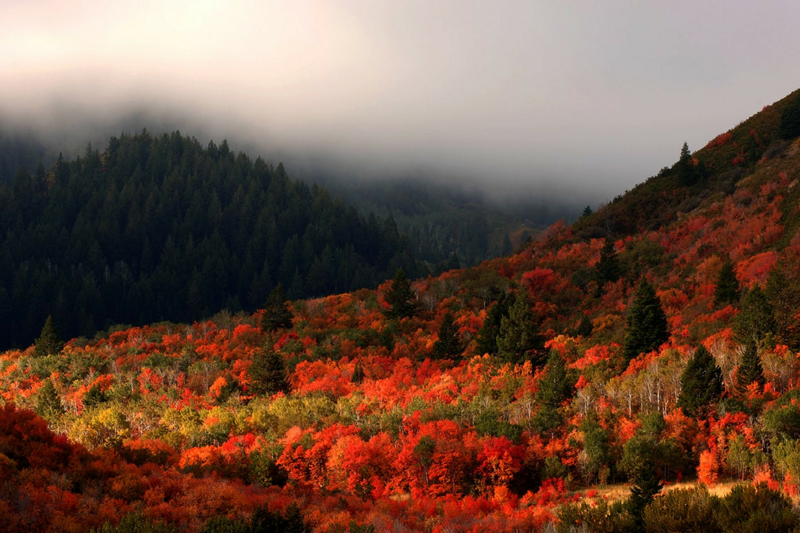
Want tips for family outings? Read some ideas for adventures here.
You’ll find abundant opportunities to hike, climb, fish, canoe - the list goes on. Top locations for hiking include the Wind Caves Trail and Tony Grove Lake - and the Second Dam and anywhere along the Logan River are great for fishing. Better still is the byway's proximity to downtown Logan. One minute, you can be catching brown trout in an alpine river and 10 minutes later, you're in a historic theatre enjoying a world-class performance.
With Logan, you get the often-considered impossible: the best of both worlds.
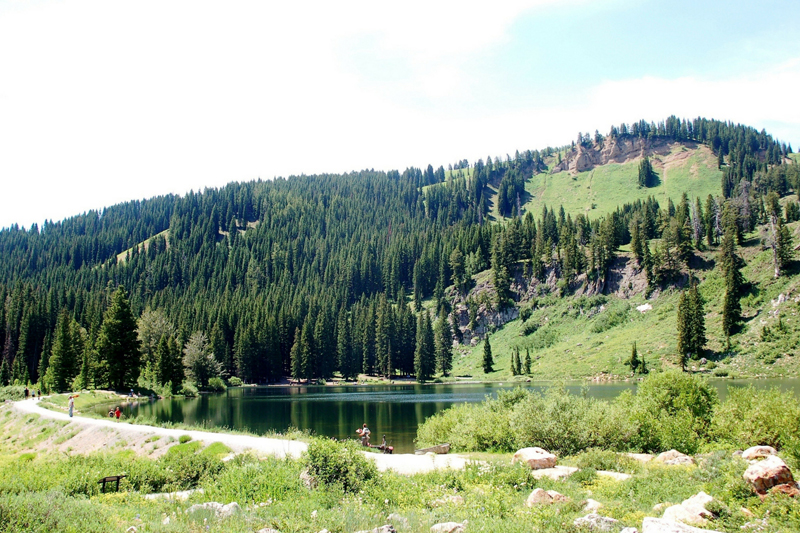
Utah's Heart of the Arts
To be, or not to be - that is not the question with Logan, when it comes to creativity. In Logan, there's no shortage of charisma and the nickname, Utah's heart of the arts, is far from whimsical. It refers to a truth about Logan: it's Utah’s pinnacle of creativity. There are dozens of professional performing arts groups and summer especially sizzles with hundreds of performances.
Caine Lyric Theatre
For exciting drama and sincere, thought-provoking acting, head to the Caine Lyric Theatre on Center street. Built in 1913, it’s open year-round and hosts a variety of shows in true repertory each summer, from mystery to comedy, musicals and drama. Good things last, and the Caine Lyric Theatre is a prime example.
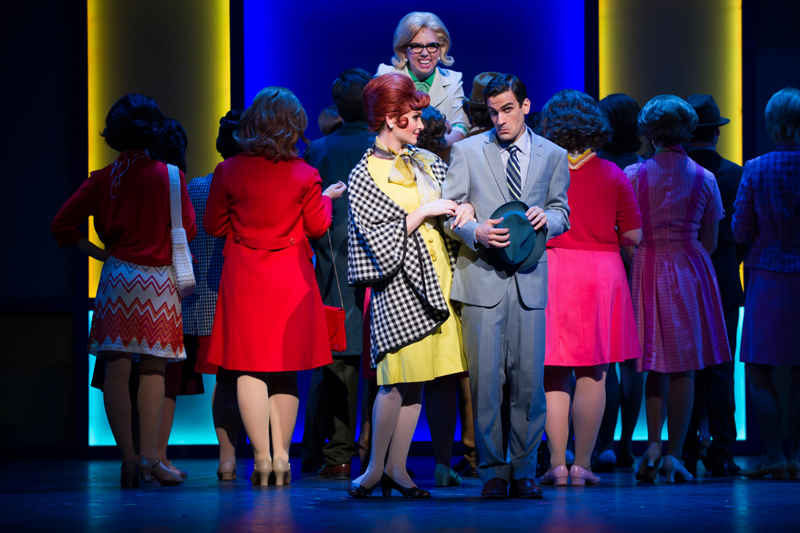
Utah Festival Opera and Musical Theatre
Opening on July the 5th and running through to August the 4th, Utah Festival Opera and Musical Theatre hosts some of the United States' top theatre performers under one roof. Coming straight from New York's Broadway and opera stages across the country, 300 or so actors take on famed works like the Barber of Seville, The Secret Garden, and You’re a Good Man Charlie Brown. This along with concerts, breakfast with performers and academy classes are yours to indulge.
Foodie Trek
Foodie treks are a great way to get familiar with a place, and Logan's isn't any different. Cache Valley exports fine foods across the globe and has gained a reputation for being a foodie-leader. You can see for yourself, embarking on their self-guided Foodie Trek. Some 20 different venues are open for you to visit, and there's no need to hold back on what you try. It features everything from ice cream and cheese to honey, coffee, and hand-dipped chocolates, and more.
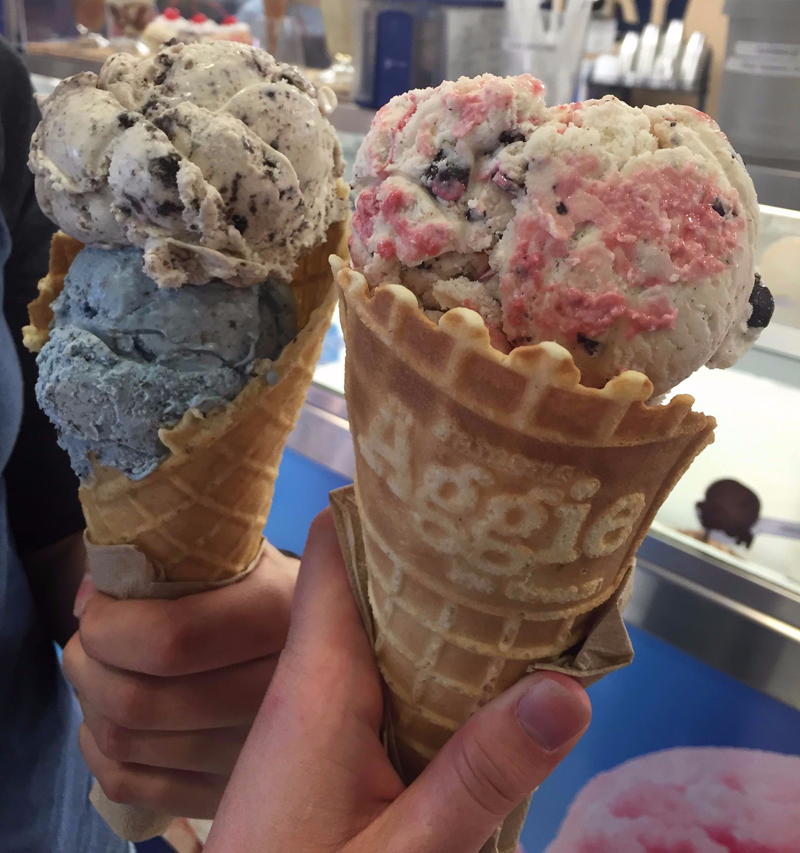
The American West Heritage Center
A final attraction worth mentioning (and visiting) is the American West Heritage Center. Home to a mountain man camp, pioneer settlements and a working farm dating back to 1917 (yes, you can pet cute farm animals or learn to milk a cow), head here to get up to speed with frontier history. It’s great for kids and adults alike.
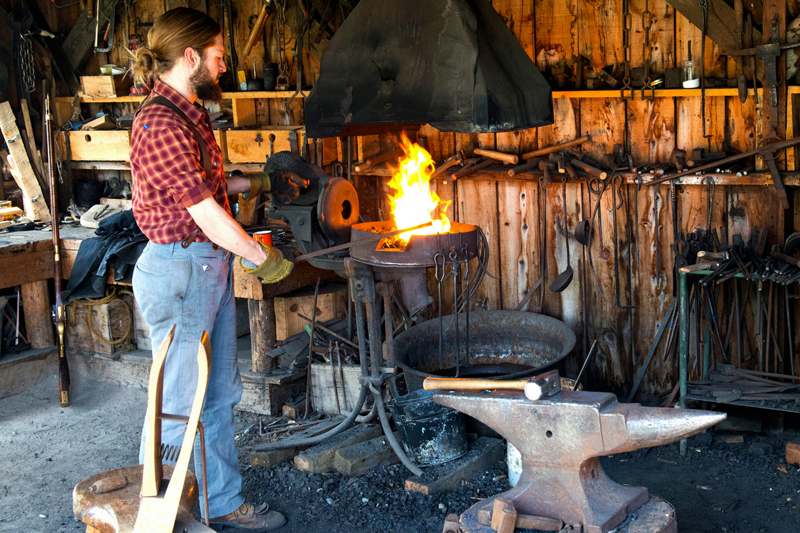
To Surmise
Logan is a captivating location. It's unique in Utah, in that it is so thoroughly creative, and utterly outdoorsy. Nothing can beat the short journey from the mountains to downtown. I can be on a perfect alpine trail and moments later, watching my favourite play, given by the world's top performers. It doesn't get any better. The area’s award-winning activities and amenities are very affordable, too - what more could you want?
This story has been created in partnership with Visit USA Parks
02/08/2018 10 Reasons You Must Visit Logan in the Summer
by RootsRated - Logan, UT - June 16, 2017

Home to Utah State University, Logan is a charming mountain town that’s filled with recreational activities. (Explore Logan)
A picturesque, mountain-fringed town at the northernmost border of Utah, Logan is home to Utah State University and a friendly assortment of college students, professors, farming families, and outdoor recreation-loving folk. This mix makes the town as charming as it is interesting. It’s an unfussy and likable place where you can play in the mountains all day, then try famous local ice cream made with milk from local ranchers.
Rising above the town is one key canyon, Logan Canyon, and an array of smaller and less visited canyons. Logan Canyon is primetime for skiing, snowboarding, rock climbing, mountain biking, and hiking. This canyon also gives access to an amazing and large freshwater lake, Bear Lake, where families can hightail it out of the summer heat and enjoy some boating or fishing.
It’s hard to cram all of Logan’s lures into one visit, but here are a few of our favorite ways to spend a day or two there.
1. Hike the Wind Caves
Just ten minutes up Logan Canyon lies one of the must-do hikes: the Wind Caves. It logs 2 miles each way, ascending to some incredible wind-carved caverns and rock formations. Naturally the spot is fascinating for kids, but anyone can appreciate the interesting beauty of these caves. The views along the way can’t be beat, either.
2. Eat at the Bluebird Restaurant
Opened a century ago, this beloved mainstay still has its hand-painted murals and old-fashioned soda fountain popular in the 1920s. The restaurant is going strong today, thanks to its simple, classic American menu and small-town ambience.
3. Go for a Horseback Ride Up Logan Canyon
Get to know the canyon’s farther reaches and spend a little time getting to know some friendly horses too. The Beaver Creek Lodge up Logan Canyon will help you arrange a guided horseback ride or an off-road adventure in a RZR side-by-side (or, in the winter, snowmobiles), which is fun for both adults and kiddos. You can even spend the night there if you’re digging the cool mountain air.
4. Go to Caffe Ibis
Caffe Ibis is "the" coffee spot in town, and it’s so well liked that the shop sells its coffee throughout the rest of the country as well. The café itself is a funky little spot that dedicates itself to sustainable, fair business practices and very tasty food. They’re open for both breakfast and lunch, with yummy baked goods and exceptional sandwiches.
5. Have a Bike Ride and Bonfire in Green Canyon
Green Canyon is a quiet side-canyon just outside town, with one main bike trail ascending its center. It makes for a mellow and scenic ride or walk—and along the way you’ll pass Scout Cave, a particularly popular place to have a bonfire. We’d dare say the combo of a bike ride, fire, and maybe a couple of frosty beverages adds up to the perfect day.
6. Stroll Main Street
Logan’s Main Street feels like stepping back into a bygone era, but there are plenty of lively shops, cafes, and small local businesses humming right along. Take a few hours to stroll, window-shop, and choose where to duck in for lunch or dinner. Jack’s Wood-fired Pizza is one particular favorite, but possibly because you can never go wrong with pizza.
7. Hit Up the Gardeners Market on a Saturday Morning
This lively tradition is held each Saturday morning all summer at the Cache Historic Courthouse on 200 North and Main Street. The Cache Valley Gardeners Market is the place to try local produce, eats, and wares—usually with interesting art and music to boot. It’s a blast to wander, alone or with kids in tow.
8. Jump into Bear Lake
An hour up-canyon from Logan, Bear Lake is a great big blue lake with little towns surrounding. There are plenty of places to camp out, grab a bite from a local diner (be sure to have a raspberry shake), and rent watercraft and beach toys. For bonus fun, time your visit to coincide with their famous Raspberry Days festival, where the favorite local crop is celebrated (and eaten en masse).
9. Savor Local History at the American West Heritage Center
Get a sense of local heritage—pioneer, early trappers, and turn-of-the-century farming—at this family-friendly living history center. There are hands-on activities and costumed interpreters to help you step back in time. They have lots of seasonally themed events to try out, from Baby Animal Days in the spring to a Harvest Festival and Haunted Corn Maze in fall. You can also arrange for a bison tour with a wagon ride.
10. See a Live Performance
Logan is Utah’s heart of the arts all summer long. They’ve got three historic theaters in their charming downtown and performers come from famous stages across the country. Utah Festival Opera and Musical Theatre presents grand opera and Broadway musicals with full orchestra, along with more than 100 concerts, lectures, classes, backstage tours and more mid-June through the first week in August. Catch a play at the Caine Lyric Theatre, which features a musical, mystery, drama and a comedy in repertory. Or take in a free concert at Noon Music at the Tabernacle every weekday mid-May through July. The longstanding popular series presents a variety of performers from flutes to harps to banjo to barbershop.
Written by RootsRated for Utah Office of Tourism.
12/18/2017 A Logan Canyon Adventure Guide
by Beth Lopez - Logan, UT - June 16, 2017
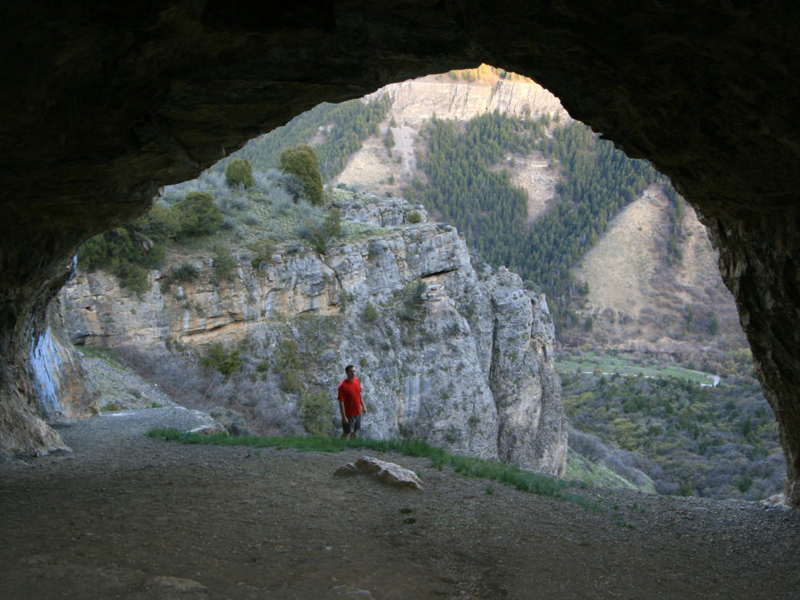
Logan Canyon is filled with memorable hikes. (Alan Cressler)
Far from any major city, a 43-mile-long mountain road winds its way through Logan Canyon, which connects the town of Logan with the shores of Bear Lake. The canyon accesses countless hiking paths, rock climbing routes, mountain biking trails, skiable acres, campsites, and secluded fishing spots. It’s the kind of place you could spend decades exploring—but even if you have only a weekend or a season, take the chance to get to know Logan Canyon’s treasures.
There’s little development within the canyon—just a small, family-owned ski resort, an overnight lodge, and a smattering of cabins and yurts. So there’s plenty of elbow room to go around. Here we’ll share a few of our favorite ways to enjoy the canyon—but keep in mind, there are secret powder stashes and perfect places to pitch a tent you’ll have to find for yourself too.
Hiking
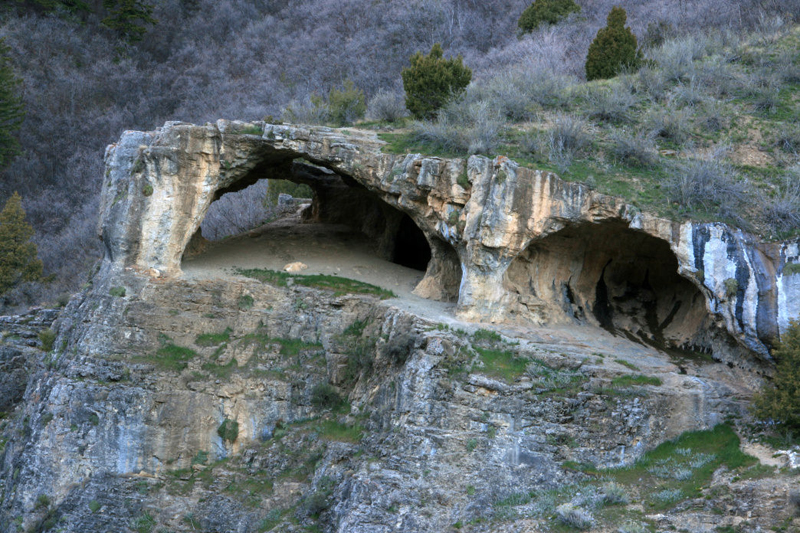
The Wind Caves feature incredible rock formations and a great view of Logan Canyon. (Alan Cressler)
There are so many hiking trails in the canyon that it’s easy to find something to suit your group’s ability level or interests of the day. Families undertake the classic Wind Cave trail, a two-mile walk up to some incredible rock caverns far up the hillside. Those interested in a higher alpine experience—and a little more mileage—head to the White Pine Lake trail. It’s about four miles each way and tops out at a stunning little mountain lake surrounded by picturesque peaks.
Mountain Biking
A mountain biking mecca, this canyon has something at nearly every difficulty level. You’ll need a full guidebook to process all the options and directions—but to start with, Beaver Creek is perfect for beginners and families. It’s essentially a dirt road that stretches on for as many miles as you care to go, passing through gorgeous meadows and groves. Those with a little more experience should try the must-do trail, the Jardine Juniper Trail. It’s a moderate climb through pristine mountain terrain, topping out at Utah’s oldest tree, a 3,200 year-old juniper.
Rock Climbing
The canyon is home to dozens of rock walls with more than 400 sport and trad routes—many of which are classics. They vary from extremely easy to ridiculously challenging, and they draw climbers from all over the country (as well as from the college town below). China Wall is an extensive limestone wall with dozens of routes to test any climber’s mettle. And First Practice Wall and Second Practice Wall offer easier and top-ropable options for those still easing into it.
Skiing
Beaver Mountain, high up in the canyon, is beloved by locals and savvy ski bums alike. It’s a no-frills, family-run resort where beginners cluster on the bunny hill—but the steeper terrain remains untracked for hours or days after a storm. The Marge’s Triple lift on the far edge of the resort offers tree glades aplenty. And the potential for backcountry skiing here is unreal: the famed "backside of The Beav" offers lift-accessed backcountry powder runs for those with the avalanche gear and know-how to pull it off safely. If a little more power is your style, rent snowmobiles across the highway and experience 300 miles of groomed trails in one of the top 10 snowmobiling destinations in the West.
Fishing

The Logan River is a blue-ribbon trout stream, offering some of the best fly fishing in the state. (Alan Cressler)
Fly-fishing aficionados flock to the Logan River, a blue-ribbon trout stream hailed as one of the best in the region. The lower dams in the canyon are stocked and make easy summer fishing spots, with brown and rainbow trout aplenty. But farther up canyon, the stream feels wilder—with clear, pristine water and cutthroat trout for the catching.
Camping
There are multiple developed campgrounds in the canyon, including Spring Hollow Campground, the Lodge Campground, and Tony Grove Campground. All are stunning in their own right and offer great access to hiking and biking trails. Tony Grove is high elevation and stays plenty cool in the summer months, making it a godsend in July and August. Of course, if tent camping isn’t really your thing, you could always get a room at Beaver Creek Lodge. Not only will you snag a cozy bed, but you’ll have access to the lodge’s guided horseback and off-road side-by-side RZR rides in summer and snowmobile rides in
We’ve only scratched the surface here with a tiny handful of place mentions—they’re a few of the high points, but plan to spend some time truly getting to know this incredible canyon. Its beauty and uncrowded nature are tough to beat any time of year.
Originally written for Utah Office of Tourism.
11/27/2017 A Foodie's Guide to Logan, Utah
By Beth Lopex (brand content opt out) - Logan, UT - June 16,2017
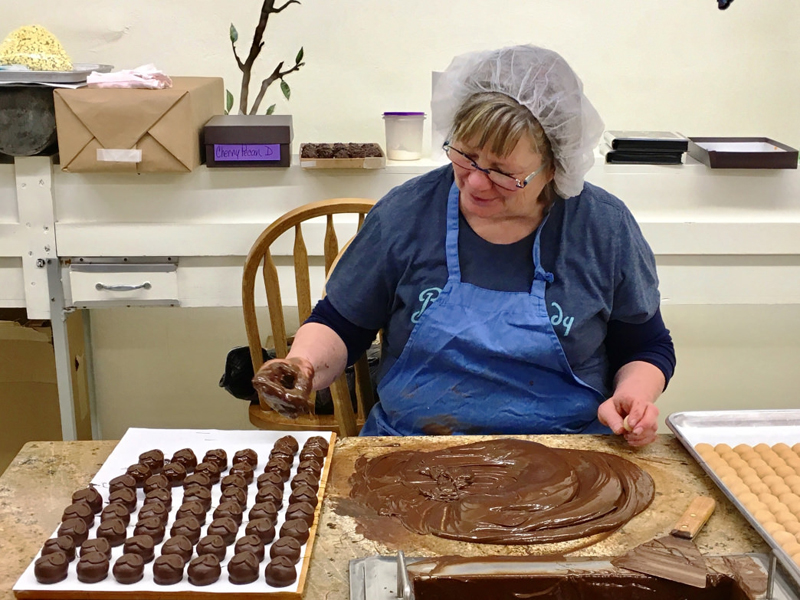
Logan, Utah, is known for its hand-dipped chocolates, as well as other foodie favorites. (Explore Logan)
Logan, Utah isn’t a highly formal foodie town—populated by college students, farmers, and outdoor recreationists, it’s a place where simple and homegrown serves best. Tradition overrides trends. And unfussy is key. For those who love to eat well, there are some very "Logan" finds here, ranging from a hundred-year-old diner to a bustling gardeners market and more than a dozen food production facilities and everything in between. They’ve even got a signature products tour to guarantee a true taste of the Valley.
They are famous for cheese plus coffee, Pepperidge Farm cookies, Cox honey from fourth-generation bee-keepers, Lower Meats, hand-dipped chocolates and more. Other unique products on the tour include handmade soaps and lotions, pajamas, and socks.
Here we’ll list just a few of our favorite stops, and what’s so uniquely local about them.
Bluebird Restaurant
This café is the longest operating in the state and has served as a town mainstay for more than a century, sitting in its current location since 1923. There are still items available from the original menu including teddy bear sundaes and shrimp, pea, and egg salad. They make their rolls with flour from Central Mills, which is ground in the area from locally grown grain. You’ll love the murals and old-time soda fountain. It’s still family run (closed Sundays) and, of course, family-friendly.
Aggie Creamery

Aggie Creamery offers a decadent treat. (Explore Logan)
Logan’s Utah State University is an agricultural institution by tradition (hence the school’s mascot, the Aggie). And nowhere does this manifest in a tastier way than at the Aggie Creamery, located on campus. Like the Bluebird, the Creamery has been there for decades. And they’ve truly perfected ice cream made with milk from local dairy cows. Its high butterfat and low air content make it decadently rich and creamy. Try the current flavor offerings like Aggie Bull Tracks or Aggie Blue Mint.
Caffe Ibis
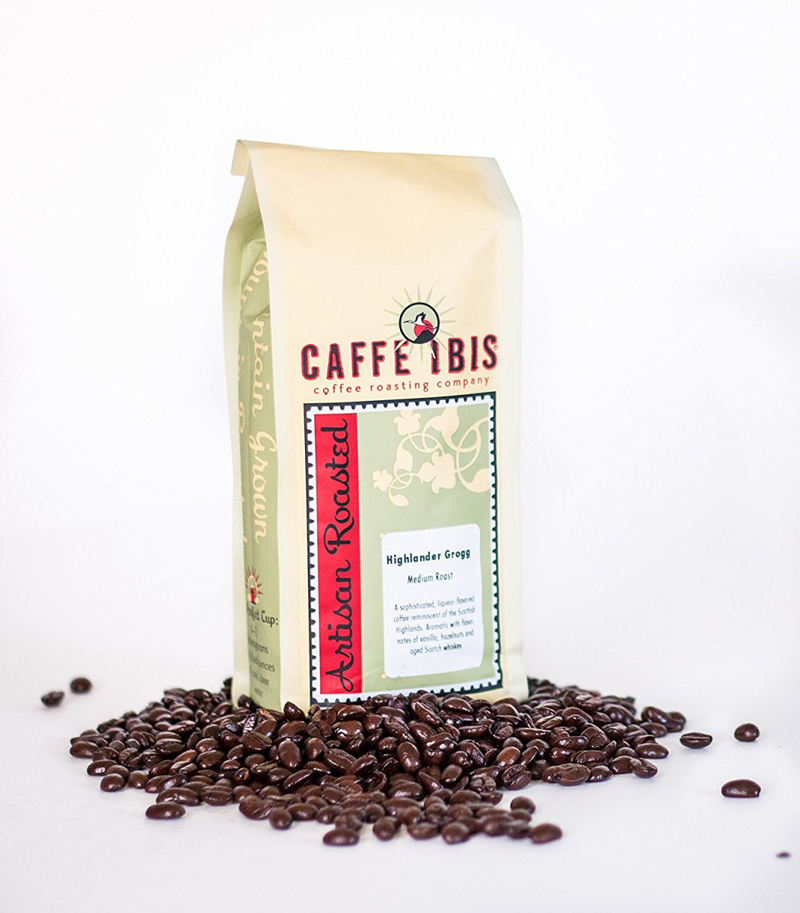
Caffe Ibis is Logan’s go-to coffee shop. (Explore Logan)
The go-to town coffee shop, Ibis’ beans have gained notoriety nationwide. But there’s nothing like ducking into the cafe itself to sample the brews alongside home-baked pastries, breakfast sandwiches, and lunch paninis. It’s an artful place with simple, sustainably sourced, and delicious food. Drop in for a quick bite to go, or settle in with a good book and stay a while.
Cache Valley Gardeners Market
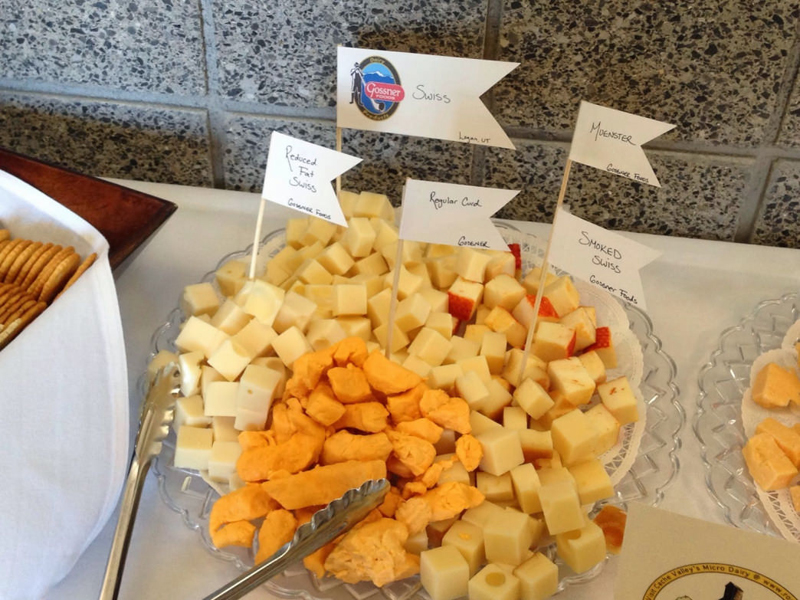
The Gardeners Market features items grown or made within a 50-mile radius of Logan, including a wide variety of cheeses. (Explore Logan)
This is one place where the town’s agricultural roots shine in a big way: the Gardeners Market has grown every year into quite a robust culinary (and cultural) delight. Held every Saturday from mid-May to mid-October from 9 a.m. until 1 p.m., this market is a food-lover’s playground. Everything sold is grown or made within a 50-mile radius, with the produce picked just hours before it hits the stand. Come hungry and come curious to sample and learn. You can now try not only fruit and veggies, but breads, cheeses, baked goods, herbs, granola, jams, honeys, and cheeses as well.
Crumb Brothers
Simply put, Crumb Brothers’ specialty European breads are ridiculously good. Like, you’ll-eat-a-whole-loaf good. And then you’ll buy another loaf to savor the next day. Their flour comes from a century-old local mill, and they carefully craft and bake their breads at a thoughtful pace. Every possible ingredient is locally sourced, and even the building uses sustainable energy sources including geothermal and solar. The only thing that could make all this any better is the sandwiches they make with their famous bread. Which is just what we recommend for lunchtime in Logan.
Le Nonne
In a little cottage in the middle of town lies an incredible Italian restaurant owned and run by a Tuscan native. The menu is jaw-droppingly good, especially considering it’s in a small Utah town far from Northern Italy. Le Nonne features homemade gnocchi, pastas, and sauces you’ll never forget. The summer patio is particularly popular—its trees offer shade on warm evenings, and the fresh air somehow makes all the fresh pasta even more fitting.
Herm’s Inn
In the early 1900s, this building started out as Herman’s Inn, a last stop-over before motorists left town and started the drive up Logan Canyon. The building was bought, restored, and transformed into a tasty and irreverent little restaurant several years ago. Now "Herm’s Inn," it feels funky and historic, serving from-scratch breakfasts and classic twists on lunch sandwiches. If you aren’t already sold, there’s a mac and cheese of the day every day, just as there should be everywhere.
Originally written for Utah Office of Tourism.
09/04/2017 7 Family-Friendly Outdoor Adventures in Logan
by Stewart Green - Logan, UT - June 16, 2017
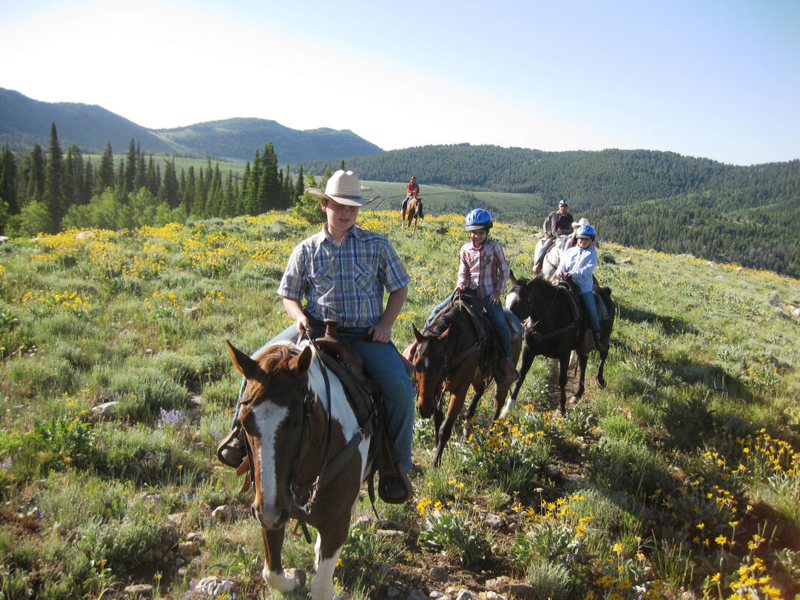
Renting horses or off-road vehicles to explore Logan Canyon is a great activity for the whole family. (Explore Logan)
Logan offers unsurpassed adventures during Utah’s long summer. The small city spreads along the interface between the Wellsville Mountains, the broad Cache Valley, and the Bear River Range, offering the best of both worlds. You’ll find plenty of amenities like parks, urban trails, and cafes in Logan, while beyond the city limits beckons a world of outdoor fun. Logan Canyon slices through the mountains, offering world-class rock climbing, miles of hiking and biking trails, fly fishing in clear streams, and spectacular scenery. Keep your family amused for a week of Logan fun with these seven great summertime activities.
1. Hike Limber Pine Nature Trail
The Limber Pine Trail, one of Logan Canyon’s most popular family hikes, crowns the canyon’s 7,800-foot summit. The 2-mile hike is great for kids with gentle grades and stunning views of the canyon and Bear Lake. One highlight is five limber pine trees that have grown together for the last 570 years. Interpretive signs teach about the surroundings. Expect wildflowers, shade trees, and birds.
2. Live the Old West at the American West Heritage Center
The American West Heritage Center just south of Logan invites you to park the car, pack away the cellphone, and time-travel back to the 1800s. This outdoor living-history museum invites you to see what life was like back in the good old days. You can easily spend the whole day here, rambling around and interacting with interpreters dressed in period costumes who go about their daily life in the Old West. There’s a pioneer settlement with a cabin and dugout; a mountain man encampment and trader cabin; a historic farm with the original 1917 house; pony rides; bison to see; and a woodworking shop. Kids can throw a tomahawk, set a beaver trap, spin wool, milk a cow, or have a two-person log-sawing contest. It’s loads of fun and a memorable living history lesson.
3. Camp, Swim, and Boat at Hyrum State Park
Hyrum State Park, with its 450-acre reservoir, is water-central for wet summer recreation in Cache Valley. The park, 15 minutes south of Logan, offers a host of family adventures. Kids can borrow a fishing pole from the park’s lending library and toss a line for rainbow trout, yellow perch, bluegill, and largemouth bass, or get on the lake by renting a standup paddleboard, kayak, or canoe. Lake View Campground on the north side of the lake offers RV and tent sites shaded by box elder, willow, and maple trees. The marina, boat ramp, and sandy swim beach are right there. There’s great birdwatching with a variety of species at the wetlands at the lake’s south end, so bring binoculars.
4. Get Natural at Stokes Nature Center
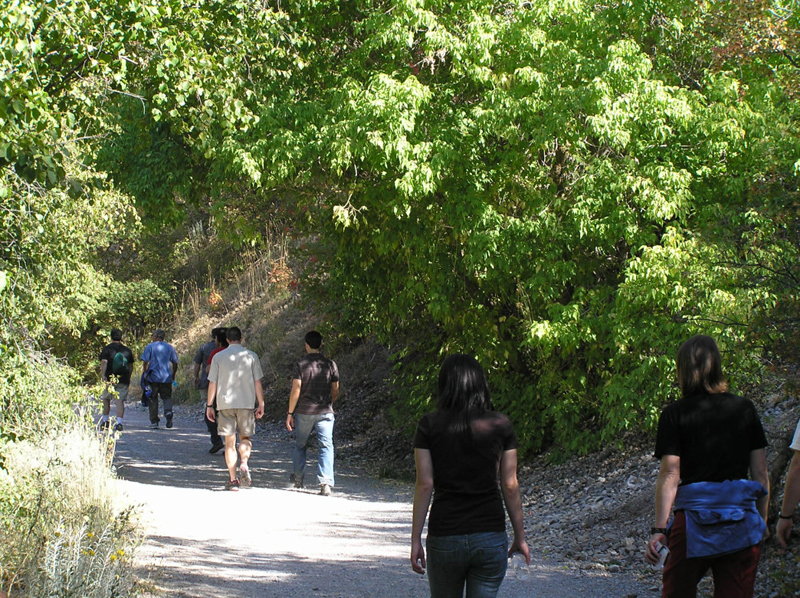
The Stokes Nature Center offers family-friendly hiking and other outdoor activities for the kids. (robmba)
Stokes Nature Center, a mile up Logan Canyon, is a fun place to learn about all creatures great and small. Stokes, reached by a short hike on the Logan River Trail, lies along the stony banks of the Logan River. The center, divided into two sections, has a preschool area with books, blocks, games, and a puppet theater. The other section offers a hands-on area for kids of all ages to learn about Utah’s plants and animals with games, mystery boxes, touch boxes with skulls and pine cones, and live animals like lizards, turtles, and snakes. After discovering natural Utah, head outside so the kids can ride a rope swing, look for trout in the river, or check out a teepee. The center also offers classes, field trips, and summer camps.
5. Camp, Hike, and Fish at Tony Grove Lake
Is there anywhere better in summer than Utah’s high country? Nope. The Bear River Range, forming Logan’s eastern horizon, is a spectacular summer playground with alpine lakes, gorgeous scenery, and cool days. Tony Grove Lake, 25 miles east of Logan off Highway 89, is the best getaway for relaxing days. The glacier-excavated lake nestles against cliffs below high peaks. Additional trails begin at Tony Grove and you’ll bask in the beauty of wildflower-strewn meadows and pine forests. Pitch a tent in the 36-site campground, then stroll around the lake on a 1.2-mile trail, launch a canoe, or fish for trout. Watch for moose wading in the lake shallows.
6. Mountain Bike on the Logan River Trail
Plenty of technical mountain bike trails lace the highlands above Logan, but the best family-friendly ride is the easy 3.6-mile Logan River Trail. The out-and-back route, gaining only 300 feet, parallels the river in deep Logan Canyon. The first couple of miles, perfect for young riders and bike trailers, is a wide gravel track with plenty of places for a picnic or to toss a few rocks in the river. Past a dam is a mile-long section of intermediate single-track trail that offers good wheeled fun. The trail eases and widens for the last half-mile, passing another dam, to its end at Spring Hollow Campground. Turn around here and ride downhill for a 7.2-mile roundtrip adventure. The trail is multi-use so you’ll share with fishermen, hikers, and trail runners.
7. Go Wild and Wooly at Zootah

A small-town zoo in the heart of Logan, Zootah features more than 300 animals for kids to enjoy. (Whitney Mortensen)
Zootah is an intimate small-town zoo in the heart of Logan. The charming and affordable zoo in Willow Park is popular with visitors, residents, and school groups who come to see over 300 animals, including birds, reptiles, and mammals like elk, an albino porcupine, lynx, bobcat, and capuchin monkeys. Zootah focuses on education and conservation, with the friendly staff showing raptors and other critters. Kids love the zoo, reveling in the diverse animals and feeding fish and ducks. Nearby are other park areas, including a shaded picnic ground, duck pond, playground, and a complex of swimming pools with a kiddie pool, diving boards, and two water slides.
Originally written for Utah Office of Tourism.
06/24/2017 The Fascinating Story Behind Logan, Utah
by Jeff Banowetz - Logan, UT - June 16, 2017
Logan, Utah, is right in the center of the high-mountain Cache Valley, a favorite place for the Northwestern Band of the Shoshone Indians, who roamed, hunted, and fished here for thousands of years. Next came the mountain men and trappers in the 1820s. They nearly depleted the area of its beaver population since hats and capes were all the rage in Europe and on the East Coast. The trappers stored their furs in "caches," a French word that means “to hide or store one’s treasure.” The caches were holes dug into the ground for their supplies and furs. Now you can find your own hidden treasure in Cache Valley.
Logan is now home to international high-tech businesses, farmers and ranchers, university students, arts lovers, and outdoor enthusiasts who still enjoy its small-town charm. The Wasatch-Cache National Forest is only 10 minutes from downtown and the world-class performing arts scene has earned Logan the nickname of Utah’s Heart of the Arts. All these facets of the community can be traced to the hobbies, innovation, and work ethic of the early pioneers who settled the valley in the 1850s.
Logan has been ranked as one of the safest cities in the nation plus the best place to be a kid, retire, and even start a business. Yet vacationers can still have much of the place to themselves.
The town itself dates back to 1859, when Brigham Young sent a group of settlers to Cache Valley to build a fort on the Logan River. By the following year, there were 100 houses in the development, which was named after Ephraim Logan, an early trapper who frequented the region. The town was laid out like Salt Lake City with wide streets and done on a grid system.
While the town of Logan wasn’t the only settlement in the Cache Valley, it soon became the largest due to its central location and abundant water, which served to supply both mills and irrigation. It became a place where farmers gathered to buy and sell their goods and eventually the city became the county seat. Early industry in the town included a sawmill, lime kiln, and a tannery. One of the first buildings built was a theater.
The first higher education came to Cache Valley when Brigham Young College was founded in 1878. After the passage of the Lund Act, the land-grant Utah State Agricultural College was founded 10 years later and its first students arrived in 1890. It’s now known as Utah State University.

People come from all over to rent horses to explore the beautiful mountains and vistas in Logan Canyon. (Explore Logan)
You can explore more about the history of the region at the American West Heritage Center, a 160-acre living history center that focuses on life in the region from 1820 to 1920. Visitors are treated to a hands-on learning environment, as mountain men, farmers, and pioneers dress in period costumes and encourage you to try your hand at fun skills and activities common for the people who lived back then.
The Hyrum Museum in the southern Cache Valley, takes an even broader view of history, with information that dates back from the prehistoric Lake Bonneville to development in the mid-20th Century. You can also check out the Daughters of the Utah Pioneers Museum in historic downtown Logan and take a tour of the Tabernacle, a great example of early Mormon architecture.
One of the first buildings built in Logan was a theater and the community has honored and built this tradition of loving the performing arts for generations. There are three historic live-performance theaters booked with great shows year-round. Ticket prices are unbelievably affordable, the scenery and costumes are spectacular and the performances are brilliant.
The natural resources that first brought settlers to the region are once again drawing visitors. Only this time, it’s with hiking boots, bicycles, and fishing rods. Due to its high elevation, summers never get too hot in Logan, which means hikers can enjoy the trails in the Wasatch-Cache National Forest spring through fall (see a complete trail map of the region to discover just how much there is to explore).

Hikers will find an abundance of scenic options in Logan Canyon. (Explore Logan/Monique Beeley)
Camping, cycling, fishing, boating, horseback riding, and golf all attract people to the area in the summer months. When you’re not outside, you can take advantage of Logan’s burgeoning dining scene, which includes everything from fine dining to ethnic favorites and casual family-style diners.
The small town charm of Logan remains. It’s off the beaten path and thankfully so.
Originally written for Utah Office of Tourism.
06/16/2017 10 Tips from Locals on How to Make the Most of Your Time in Logan
by Beth Lopez - Logan, UT - June 16, 2017
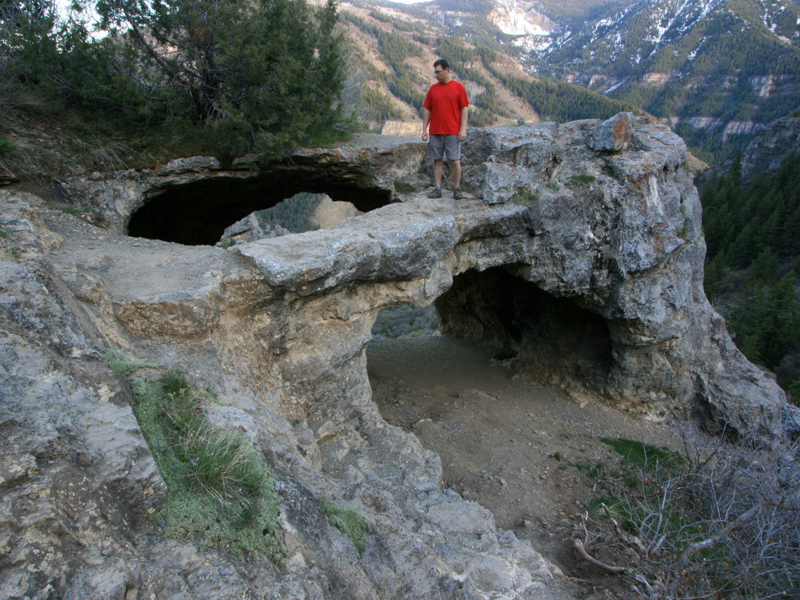
Logan, Utah, is known for its excellent hiking trails. (Alan Cressler)
The bustling community of Logan is just 80 miles from Salt Lake City, but it feels a world away. Set in Cache Valley between the Wellsville and Bear River Mountains, Logan is home to Utah State University, and it has a friendly, small-town vibe. Logan offers fast access to outdoor adventures like hiking, biking, climbing, boating, and skiing along with world-class performing arts. We went straight to the source, asking locals what they would recommend for first-time visitors to Logan. Here are the 10 tips they came up with:
1. Explore the Wind Caves
Located five miles up Logan Canyon, this steep hike takes you four miles roundtrip and 2,300 feet up to a natural limestone triple arch and cave. On clear nights, views of Logan Canyon and the Milky Way make the Wind Caves one of the area’s most popular trails. If hiking at night, come prepared with headlamps to light your way. On summer days it’s best to hike early, as the trail is exposed and can be hot.
2. Embrace Your Inner Foodie
Logan has an array of unique and affordable locally owned restaurants, but foodies will especially appreciate a true taste of Cache Valley by taking a self-guided Cache Valley Signature Products Tour. You can visit more than a dozen businesses that make everything from cheese to cookies and ice cream to honey. And yes, there are samples! In addition to tasty treats from Gossner Cheese, Cox Honeyland, and Bluebird Chocolates you will also find handmade soaps, lotions, pajamas, and socks along the tour.
3. Take to the Rocks
Experienced rock climbers flock to Logan Canyon to ascend its overhanging limestone and quartzite faces from spring through fall. Cool canyon temperatures and low humidity make it enjoyable even in the summer. The majority of the canyon’s 275 routes are bolted sport climbs ranging in difficulty.
4. Camp Under the Stars

Logan Canyon National Scenic Byway is filled with scenic camping spots. (Devin Stein)
Enjoy the night sky or sleep in a cozy cabin at Hyrum State Park. This 450-acre manmade lake is a popular spot to boat, kayak, swim, waterski, wakeboard, and canoe. Canoe and boat rentals are available all summer long. Cast a line along the sandy shores and let the kids play along the beach. It's just 15 minutes from Logan in the town of Hyrum, so city amenities are easily accessible if you need them.
5. Hop on a Road Bike
Cache Valley and Logan’s diverse road biking options make it a popular place for new and experienced cyclists alike. Start with a flat, fast ride through Cache Valley’s beautiful rural farmlands—where you’re more likely to see a cow than a car. Then challenge yourself by pedaling 36 miles up and down Blacksmith Fork Canyon past canyon walls and hiking trails. Turn around at Hardware Ranch for a fast down-canyon descent.
6. Explore the Valley
Pick up or download a copy of the Heritage Driving Tour and spend a day or two visiting some or all of the charming 29 communities nestled in the 50-mile-long Cache Valley. It extends from Utah into Idaho and you’ll journey past huge fields of crops, cattle ranches, historic homes and untouched beauty. There are plenty of fun nuggets of information about each town and there’s even one called Paradise. Everyone should say they’ve been to Paradise and now you really can!
7. Go Fishing at Mountain Valley Trout Farm
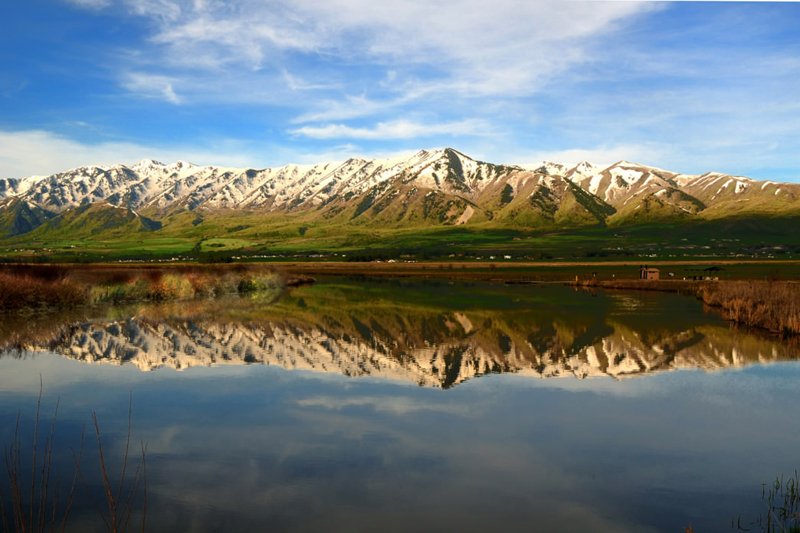
Go fishing for trout in the shadow of the Wellsville Mountains. (Explore Logan)
You don’t need a fishing license to cast a line at Mountain Valley Trout Farm. Practice catch and release if you’d like, or keep the fish you catch and have it cleaned and filleted before you leave. Located in nearby Smithfield with a beautiful view of the Wellsville Mountains.
8. Catch a Show
Logan is Utah’s heart of the arts all summer long. They’ve got three historic theaters in their charming downtown and performers come from famous stages across the country. Utah Festival Opera and Musical Theatre presents grand opera and Broadway musicals with full orchestra, along with more than 100 concerts, lectures, classes, backstage tours and more mid-June through the first week in August. Catch a play at the Caine Lyric Theatre, which features a musical, mystery, drama and a comedy in repertory. Or take in a free concert at Noon Music at the Tabernacle every weekday mid-May through July. The longstanding popular series presents a variety of performers from flutes to harps to banjo to barbershop.
9. Hike Around Tony Grove Lake
If you're looking for an easier hike with a view, then hike to Tony Grove Lake This simple 1.2-mile trail winds around the lake. If you don't feel like hiking, you can rest your feet and take a kayak or canoe on its glacial waters. Fisherman flock to the beautiful lake too, but it’s actually best known for the spectacular summer wildflowers and brilliant fall colors that surround it.
10. Explore the Past at the American West Heritage Center
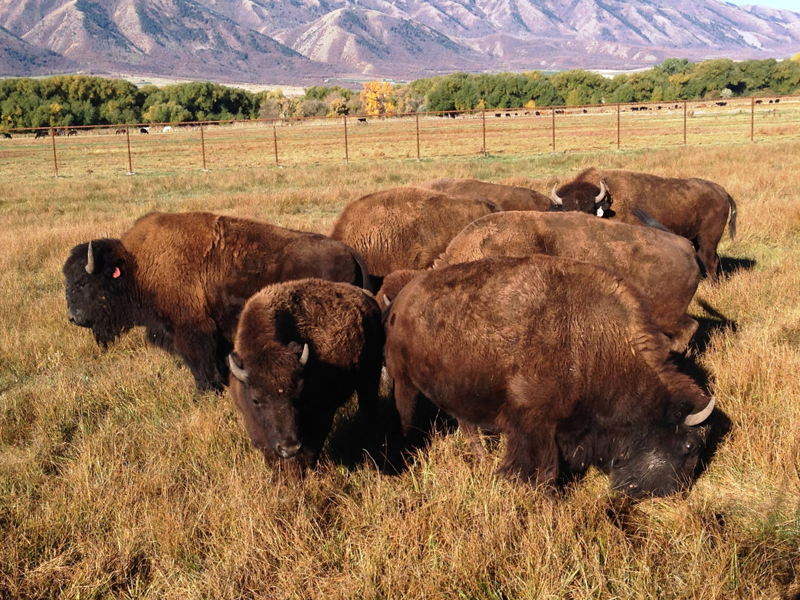
The American West Heritage Center offers visitors a look back at a time when the buffalo roamed—and you can see them for yourself. (Explore Logan/Julie Hollist)
Step back in time to experience the true Old West at the American West Heritage Center where history comes alive. Explore the Mountain Man Camp, pioneer settlements and 1917 working farm. Each venue has a variety of hands-on activities for you to try, demonstrations, and interpreters in period clothing to give you a taste of the past. Throw hatchets or learn to set traps with the mountain men; make rag dolls or compete in a two-man log-sawing contest on the pioneer site; learn to spin wool, weave rugs, milk a cow, check out the bison, or just enjoy the fresh mountain air and beautiful scenery on a wagon ride around the site.
Originally written for Utah Office of Tourism.
